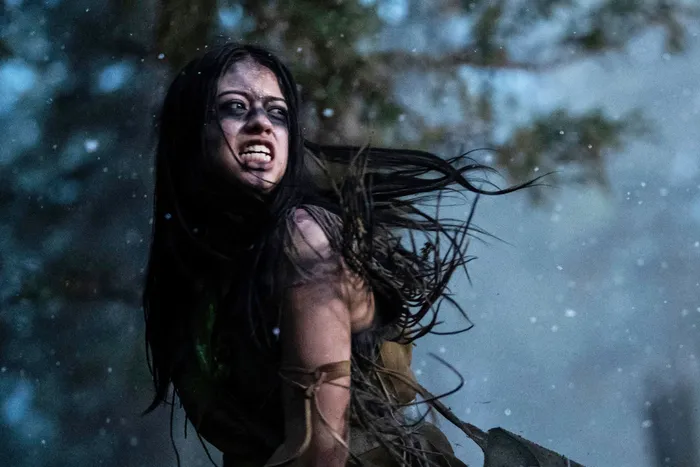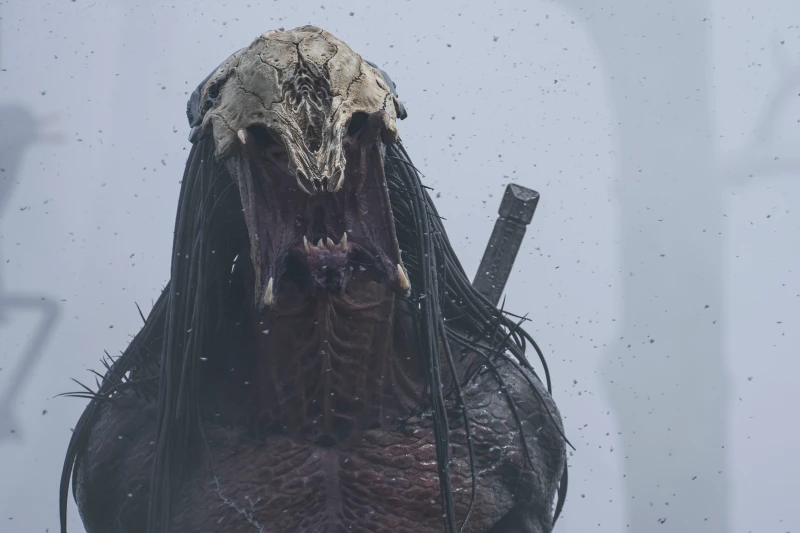In this era where nearly every big-budget Hollywood genre film is a comic book adaptation, distant sequel, or reboot desperately clawing at franchise potential, Prey is a godsend. Director Dan Trachtenberg, screenwriter Patrick Aison, and cinematographer Jeff Cutter have created a new installment for one of Sci-Fi’s most beloved and iconic franchises that stands tall as an expertly-crafted re-imagining. Starring Sioux actress Amber Midthunder, Prey changes the perspective to that of a Comanche tribe 300 years ago and reintroduces the iconic Predator in a much more primal form. These changes, plus a robust thematic core that utilizes the film’s cast, setting, and real-world history to significant effect, land audiences with a film that rivals the original Predator as the best film in the franchise – and an absolute must-see for genre fans.
Almost 300 years before Major Dutch and his team of special-ops would take on the Predator in the jungles of South America, a Yautja (the canon name for the Predator species) lands in the Northern Great Plains to take trophies from a largely un-hunted Earth. At the same time, Naru – played by Midthunder – is attempting to prove to her Comanche tribe that she is every ounce the hunter her older brother and the rest of the men are. She and the other hunters cross paths with the alien killer (as well as some white French fur traders), and the action begins.
There are two main ingredients for why Prey works so well. The first is that the film knows the audience is well aware of what the Predator is. As a result, the slow, tense buildup that worked so perfectly in the original 1987 film isn’t needed. Instead, Trachtenberg and Co. tease how this Predator differs from past iterations. While the original had the alien trophy hunter leaving trails of skinned bodies and silently tracking soldiers via trees, Prey sees a Yautja steadily “dipping his toe” into a new world’s potential quarry before ever coming up against humans. This plot progression parallels the film’s other main ingredient: how much Prey cares about its characters.
MFR ON YOUTUBE (latest video)
Help us reach 5K Subs!
Naru, the film’s protagonist, is immediately set up as a relatable and very human character. While she’s a skilled survivalist and competent hunter, most of her tribe refuse to see her as anything more than a gatherer and healer. She is joined by her brother and the tribe’s best hunter Taabe, played by Dakota Beavers, her sympathetic but lightly condescending mother Aruka, played by Michelle Thrush, and most importantly her faithful canine companion, Sarii. Watching Naru bounce off these characters and have meaningful conversations while simultaneously witnessing her development as a warrior is highly endearing. We, as an audience, are compelled to root for Naru as she struggles and innovates her way through the increasing brutality of the Predator’s hunt – as well as other obstacles thrown in her path. Her existence as a character is truthfully a testament to what the Predator films have been since the beginning. Strength and conventional combat ability aren’t factors against the Predator – only cunning is. We watched a team of elite spec-ops armed with the best weaponry the U.S. Government can provide get massacred one by one in the original. What ended up winning? Survival skill and intelligence by using traps made of sticks and stones. In this regard, Naru is the toughest and most capable protagonist we’ve witnessed in this series thus far. Her entire existence revolves around survival skills and understanding the environment. The fact that she is also such a relatable and well-crafted character in all other regards makes her the best protagonist in the Predator franchise’s 35-year history. These well-constructed elements in both herself and her supporting cast make the audience worry more about the risks they take and help make the film all the more intense.

Speaking of intensity, Prey stands tall not only in this franchise but in the genre as a whole with a perfect mixture of tension, well-choreographed action, and ever-brutal kills. The steady buildup to the meeting between the Predator and the Comanche doesn’t utilize the mystery of the first film – again, it doesn’t need to. Instead, the first act of Prey utilizes a sense of dramatic irony. We, the audience, know what Naru and her tribe are about to come up against, while they have no idea. This builds a different kind of tension that is almost as effective as the unknown threat the alien posed in Predator. Even with most of the mystery about the Predator uncovered, this new iteration still gives viewers plenty to be surprised by. With a more warrior-like hands-on approach, cool new killing tools, and a more “feral” physical design, the iconic movie monster still offers plenty of surprises to keep things fresh yet familiar. Prey also boasts the most impressive fight sequences and some of the most gnarly kills the franchise has seen. There are points where you would think the Feral Predator is more interested in experimenting with the art of blood spray than he is in taking trophies. Scenes where the hunter goes toe to toe with some of Earth’s greatest carnivores, are intense and insanely cool, but even those moments are topped when humans decide to challenge this invader. Outside of the tense and crafty final showdown between Nary and the Predator, a sequence where Naru’s fellow hunters face off against him and a particular fog and ash-covered slaughter-spree (you know the one) are absolute franchise highlights.

Prey‘s more technical filmmaking aspects almost never fail to impress. Director Dan Trachtenberg, best known for being at the helm of acclaimed cult-hit 10 Cloverfield Lane, leads in the process of crafting a genre piece that is intense and compelling from beginning to end. His filmmaking decisions, from his focus on practical effects to implement a new Predator design, and even consulting with a Comanche culture-bearer in the late Juanita Pahdopony, show that he displays a lot of adoration for this series while still wanting to push it in new directions. The authenticity of the depiction of Comanche culture is one of the film’s most endearing qualities, and it’s an element made possible by producer Jhane Myers. Creating this representation of a Native American tribe in the early 18th century with this level of authenticity is almost unheard of in blockbuster films, making Prey all the more important. There’s a nice bit of historical commentary in the movie as well, established by the invasive presence of French fur traders. The movie opens with a line of narration from Naru about a monster coming to their lands. Obviously, this implies the Predator. However, in the film’s opening moments, Sarii is caught in a spring trap. There are two invading “monsters” at play here, and while the Predator is the most immediate and direct threat, the traders are some of the first in a long line of dangers to come.

Prey‘s script, written by Patrick Aison and co-written by Trachtenberg, keeps itself feeling fresh due to the aforementioned efforts while still paying homage to the films in the series before it. The movie keeps all those core elements of a Predator film intact but with more thematic resonance than prior entries. There are scenes that are absolute homages to prior films. Not just easter eggs either (which are there, but used sparingly), but direct filmmaking parallels. The fact that in the year 2022, in the era of franchise films beating audiences over the head with endless references to other pieces of media, having one that scratches this itch more subtly is a welcome treat on its own. Jeff Cutter’s cinematography is likely the best in the series, with beautiful lingering shots that utilize the environment’s natural light. While there is no doubt some environmental CGI at work, it’s utilized so well that it goes mostly unnoticed. There are a couple moments where the VFX betrays the film’s modest (though still unrevealed) budget.
These visual hiccups are the film’s one shortcoming, and it’s not the fault of the VFX studio but Disney’s decision to cut whatever budget the film had and then throw it exclusively on a streaming service. It’s an utterly bizarre decision that, due to the recent events over at Discovery/Warner and HBO Max, is also a bit disconcerting. Disney clearly doesn’t entirely know what to do with their ownership of the Predator IP (or its sister series in Alien), but there is a silver lining in that regard. Disney just throwing thumbs-ups to projects in this series gives creators a level of freedom that they didn’t have a few years prior with such an intense focus on massive franchise potential – a problem created by Disney with the MCU and Star Wars. Of course, the flip side is that they end up pawning these projects off on streaming services, so let’s hope a physical release is forthcoming.
After some unfortunate detours, Prey is the re-imagining the Predator franchise desperately needed. A combination of great filmmakers in Dan Trachtenberg, Patrick Aison, Jeff Cutter, and others with the cultural insight provided by producer Jhane Myers and consultant Juanita Pahdopony has resulted in a genre film as thematically resonant as it is badass. With excellent characterization, fantastic additions to Predator lore, perfect pacing, and some of the best Native American representation done in a Hollywood film, Prey is the best film in the series since the 1987 original.

